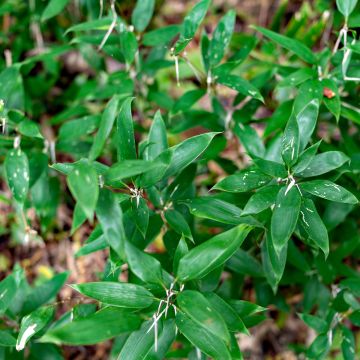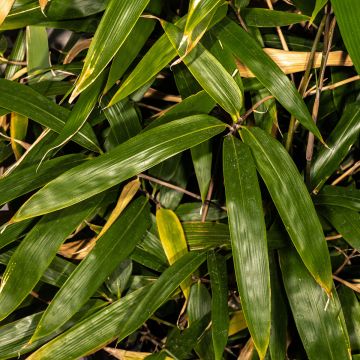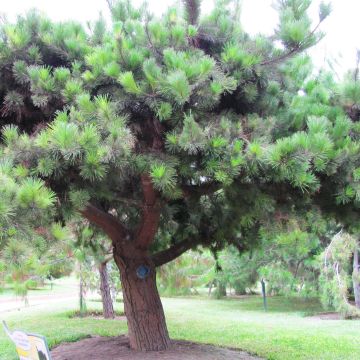

Sasa tessellata
Sasa tessellata
Sasa tessellata
Arrow Bamboo
beautiful plant
Gerard T., 14/11/2018
Special offer!
Receive a €20 voucher for any order over €90 (excluding delivery costs, credit notes, and plastic-free options)!
1- Add your favorite plants to your cart.
2- Once you have reached €90, confirm your order (you can even choose the delivery date!).
3- As soon as your order is shipped, you will receive an email containing your voucher code, valid for 3 months (90 days).
Your voucher is unique and can only be used once, for any order with a minimum value of €20, excluding delivery costs.
Can be combined with other current offers, non-divisible and non-refundable.
Home or relay delivery (depending on size and destination)
Schedule delivery date,
and select date in basket
This plant carries a 24 months recovery warranty
More information
We guarantee the quality of our plants for a full growing cycle, and will replace at our expense any plant that fails to recover under normal climatic and planting conditions.

Would this plant suit my garden?
Set up your Plantfit profile →
Description
This small evergreen bamboo is bushy and compact, and displays beautiful trailing foliage with very large dark green, glossy leaves. Its thin green canes disappear under the luxuriance of the foliage. Low-maintenance and hardy, it thrives in light sun as well as dense shade, in any moist soil. A must-have for Japanese gardens!
Sasa tessellata is a dwarf bamboo, belonging to the family of Poaceae or Grasses, native to the humid forests of China and Japan. This modest bamboo displays thin and slender canes measuring up to 1.50 m (5ft) or even 2 m (7ft). Low-maintenance and fast-growing, it grows in spreading clumps, forming a beautiful rounded and compact bush, with an erect and trailing habit. It has the longest foliage of all bamboo species adapted to temperate climates. Measuring 30 to 60 cm (12 to 24in) long and 7 to 10 cm (3 to 4in) wide, its evergreen leaves are oblong, thick, and glossy dark green. The leaf edges tend to dry out in winter, giving this bamboo a variegated character during that season. The green canes, with a diameter of 1cm (1in), with persistent sheaths and covered with a waxy bloom, grow in spreading clumps and often have only one branch per node, disappearing and bending under the mass of luxuriant foliage.
This bamboo is very easy to grow, robust, perfectly hardy, and truly undemanding, forming a dense clump with beautiful trailing dark green foliage. It is perfectly suited for small or large gardens. It thrives in any exposure, even intense shade, and tolerates some sun, very dry soils, and windy situations. Sasa tessellata can be used in multiple ways. It can be used in woodland areas as ground cover under trees such as Japanese angelica tree and Japanese maple; or integrated into a shrub border in shade or partial shade, alongside mountain laurels, sacred bamboos, and Leucothoe. It can also be used as a medium-sized hedge with virtually no maintenance. It can find a place in a rockery, on a slope, or isolated on a lawn. This dwarf bamboo is also perfectly suited for growing in a large container or planter, on a terrace or balcony. It can be paired with black bamboo and Metake bamboo, with different stems and foliage, for a highly successful tropical scene. With its exotic appearance, Sasa tessellata is the ideal bamboo to give a Japanese character to your borders thanks to its splendid luxuriant foliage, bushy and trailing habit.
In Asian cuisine, the large leaves of Sasa tessellata are used for steaming and wrapping food.
Report an error about the product description
Sasa tessellata in pictures


Plant habit
Foliage
Botanical data
Sasa
tessellata
Poaceae
Arrow Bamboo
East Asia
Other Dwarf Bamboos
View all →Planting and care
Sasa tessellata is an easy-to-grow, undemanding bamboo. It can be planted in spring or autumn. Despite being non-invasive, it is still advisable to place a rhizome barrier during planting to limit its spread. Perfectly hardy, it can tolerate temperatures as low as -18°C (1°F). It thrives in light sun, as well as partial shade, and grows well in intense shade. It should be planted in a position sheltered from the wind. Too much sun exposure can cause leaf burn. Although it is very adaptable to soil type, it prefers a rich, moist to wet, well-drained, neutral to slightly acidic soil. It can tolerate temporary drought quite well. For container cultivation, use well-draining potting soil and feed twice a year. Propagation can be done through rhizome cuttings or division of clumps. The only maintenance required for Sasa tessellata is to cut the old canes when new ones appear.
Planting period
Intended location
Care
-
, onOrder confirmed
Reply from on Promesse de fleurs
Similar products
Haven't found what you were looking for?
Hardiness is the lowest winter temperature a plant can endure without suffering serious damage or even dying. However, hardiness is affected by location (a sheltered area, such as a patio), protection (winter cover) and soil type (hardiness is improved by well-drained soil).

Photo Sharing Terms & Conditions
In order to encourage gardeners to interact and share their experiences, Promesse de fleurs offers various media enabling content to be uploaded onto its Site - in particular via the ‘Photo sharing’ module.
The User agrees to refrain from:
- Posting any content that is illegal, prejudicial, insulting, racist, inciteful to hatred, revisionist, contrary to public decency, that infringes on privacy or on the privacy rights of third parties, in particular the publicity rights of persons and goods, intellectual property rights, or the right to privacy.
- Submitting content on behalf of a third party;
- Impersonate the identity of a third party and/or publish any personal information about a third party;
In general, the User undertakes to refrain from any unethical behaviour.
All Content (in particular text, comments, files, images, photos, videos, creative works, etc.), which may be subject to property or intellectual property rights, image or other private rights, shall remain the property of the User, subject to the limited rights granted by the terms of the licence granted by Promesse de fleurs as stated below. Users are at liberty to publish or not to publish such Content on the Site, notably via the ‘Photo Sharing’ facility, and accept that this Content shall be made public and freely accessible, notably on the Internet.
Users further acknowledge, undertake to have ,and guarantee that they hold all necessary rights and permissions to publish such material on the Site, in particular with regard to the legislation in force pertaining to any privacy, property, intellectual property, image, or contractual rights, or rights of any other nature. By publishing such Content on the Site, Users acknowledge accepting full liability as publishers of the Content within the meaning of the law, and grant Promesse de fleurs, free of charge, an inclusive, worldwide licence for the said Content for the entire duration of its publication, including all reproduction, representation, up/downloading, displaying, performing, transmission, and storage rights.
Users also grant permission for their name to be linked to the Content and accept that this link may not always be made available.
By engaging in posting material, Users consent to their Content becoming automatically accessible on the Internet, in particular on other sites and/or blogs and/or web pages of the Promesse de fleurs site, including in particular social pages and the Promesse de fleurs catalogue.
Users may secure the removal of entrusted content free of charge by issuing a simple request via our contact form.
The flowering period indicated on our website applies to countries and regions located in USDA zone 8 (France, the United Kingdom, Ireland, the Netherlands, etc.)
It will vary according to where you live:
- In zones 9 to 10 (Italy, Spain, Greece, etc.), flowering will occur about 2 to 4 weeks earlier.
- In zones 6 to 7 (Germany, Poland, Slovenia, and lower mountainous regions), flowering will be delayed by 2 to 3 weeks.
- In zone 5 (Central Europe, Scandinavia), blooming will be delayed by 3 to 5 weeks.
In temperate climates, pruning of spring-flowering shrubs (forsythia, spireas, etc.) should be done just after flowering.
Pruning of summer-flowering shrubs (Indian Lilac, Perovskia, etc.) can be done in winter or spring.
In cold regions as well as with frost-sensitive plants, avoid pruning too early when severe frosts may still occur.
The planting period indicated on our website applies to countries and regions located in USDA zone 8 (France, United Kingdom, Ireland, Netherlands).
It will vary according to where you live:
- In Mediterranean zones (Marseille, Madrid, Milan, etc.), autumn and winter are the best planting periods.
- In continental zones (Strasbourg, Munich, Vienna, etc.), delay planting by 2 to 3 weeks in spring and bring it forward by 2 to 4 weeks in autumn.
- In mountainous regions (the Alps, Pyrenees, Carpathians, etc.), it is best to plant in late spring (May-June) or late summer (August-September).
The harvesting period indicated on our website applies to countries and regions in USDA zone 8 (France, England, Ireland, the Netherlands).
In colder areas (Scandinavia, Poland, Austria...) fruit and vegetable harvests are likely to be delayed by 3-4 weeks.
In warmer areas (Italy, Spain, Greece, etc.), harvesting will probably take place earlier, depending on weather conditions.
The sowing periods indicated on our website apply to countries and regions within USDA Zone 8 (France, UK, Ireland, Netherlands).
In colder areas (Scandinavia, Poland, Austria...), delay any outdoor sowing by 3-4 weeks, or sow under glass.
In warmer climes (Italy, Spain, Greece, etc.), bring outdoor sowing forward by a few weeks.


















































